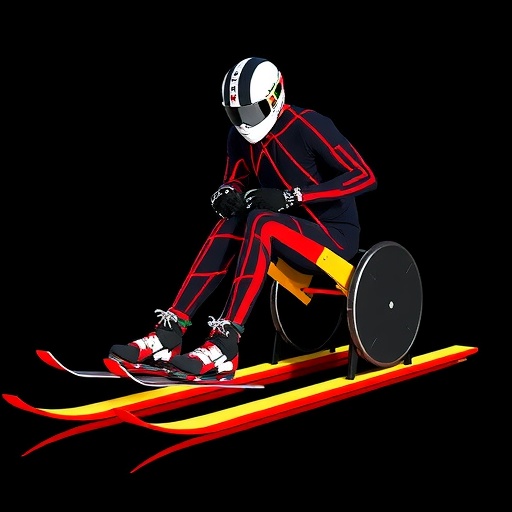In recent years, the expansion of adaptive sports has emphasized the importance of equipment modifications to enhance the performance and experience of athletes with disabilities. Among these adaptations, cross-country sit-skiing has emerged as a sport where innovation intricately influences an athlete’s ability to compete and excel. A groundbreaking study conducted by Berg et al. has delved deeply into the dynamics of force distribution within these crucial modifications, providing insights that could enhance not only performance but also the overall design of sports equipment.
The study’s focus on cross-country sit-skiing represents a synthesis of biomechanics and engineering, showcasing how athletes utilize force in ways that diverge sharply from traditional skiing. Through utilizing advanced techniques in force analysis, the researchers have laid the groundwork for future innovations in the equipment used by para-athletes. It is vital to recognize that understanding the forces exerted by athletes during their performance is not merely academic; it has practical implications that could redefine the standards of design, manufacturing, and user testing for adaptive sports gear.
At the heart of the study is the concept of force distribution, which refers to how force is transmitted and utilized across different interfaces between athlete and equipment. In adaptive skiing, where the sit-ski serves as an extension of the athlete’s body, the efficiency of this force transfer is paramount. The research highlighted how various modifications can alter force application in ways that substantially affect speed, efficiency, and ultimately success in competition.
Berg and his colleagues employed a combination of computational modeling and experimental data collection to investigate the ways that different sit-ski designs influence athletic performance. This approach allowed them to draw correlations between equipment features—such as frame stiffness, weight distribution, and ski base material—and the athletes’ ability to generate and control force. Importantly, this correlation affirms the idea that bespoke sports equipment can elevate an athlete’s performance through tailored interactions that meet their unique body mechanics.
In analyzing the data, the researchers donned the roles of both scientists and advocates, striving for progress within disability sports. By dissecting the data, they offered practical recommendations for manufacturers and designers. These suggestions included which materials to prioritize and how to configure various elements of the sit-ski to maximize force transfer efficiency. Such insights are invaluable as they pave the way for evidence-based design practices aimed directly at improving the competitive edge of para-athletes.
Moreover, the study’s findings are essential for understanding not just the mechanics of force application, but also the psychological and emotional aspects of competing in para-sports. Athletes equipped with well-designed gear are not just more likely to perform better; they also experience increased confidence and empowerment. Every gain in efficiency translates into higher speeds—factors that can dramatically alter an athlete’s race time and, by extension, their competitive prospects.
It’s noteworthy that the implications of Berg et al.’s research extend beyond the specific context of cross-country sit-skiing. The principles at play can potentially apply to a wide range of adaptive sports where the interface between athlete and equipment is crucial. This could inspire future studies that explore similar metrics in sports like wheelchair racing, adaptive surfing, and even para-athletics, broadening the overall understanding of how modifications enhance competitive opportunities.
As the adaptive sports field continues to evolve, studies like this are vital for highlighting the intersection of technology, design, and athletic performance. By pushing the envelope on research, Berg and his team not only expand the lip of current knowledge but also actively contribute to a growing movement advocating for better integration of science and sport. They demonstrate how thorough research can lead to innovative designs that support the capabilities of athletes with disabilities.
Crucially, these enhancements in equipment will lead to a ripple effect throughout the sporting community. As performance improves, so too do the perceptions of adaptive sports within the public sphere. Greater visibility and recognition will further fuel investment from both sponsors and manufacturers, steering more resources into the development of cutting-edge solutions tailored to para-athletes.
Citizens and fans of sports, as well as institutions dedicated to promoting inclusivity, should rally around such research endeavors. Raising awareness about the innovative marriage of science and sports equipment modifications can galvanize support on multiple fronts—from increased funding for research projects to public advocacy for enhanced accessibility within sports arenas and competitions worldwide.
In conclusion, Berg et al.’s study stands as a landmark investigation into the finite details of adaptive sports equipment and the critical role it plays in athlete performance. By elucidating the complex avenues of force distribution, it points to a future rich with potential, where every effort made towards enhancing equipment could lead to extraordinary gains for athletes in the Paralympic arena. The ongoing dialogue between science and sport must continue, ensuring that adaptive athletes can achieve heights previously thought unattainable.
In this world where every millisecond counts and each force applied holds the potential to change the outcome of a race, research such as this is foundational. It serves not only to empower athletes, but also to inspire a culture of inclusivity and innovation within the sporting world. The torch for progress is now firmly in the hands of those who embrace these insights, ensuring that the path to excellence remains open to all.
Subject of Research: Force distribution in sports-equipment modifications for cross-country sit-skiing.
Article Title: Analyzing force distribution in sports-equipment modifications: a paralympic cross-country sit-ski study.
Article References:
Berg, M.F., Skjølsvik, K., Døsvik, H. et al. Analyzing force distribution in sports-equipment modifications: a paralympic cross-country sit-ski study. Sports Eng 28, 37 (2025). https://doi.org/10.1007/s12283-025-00517-4
Image Credits: AI Generated
DOI: https://doi.org/10.1007/s12283-025-00517-4
Keywords: Adaptive Sports, Cross-Country Sit-Skiing, Force Distribution, Equipment Modifications, Para-Athletes, Biomechanics, Performance Enhancement.




